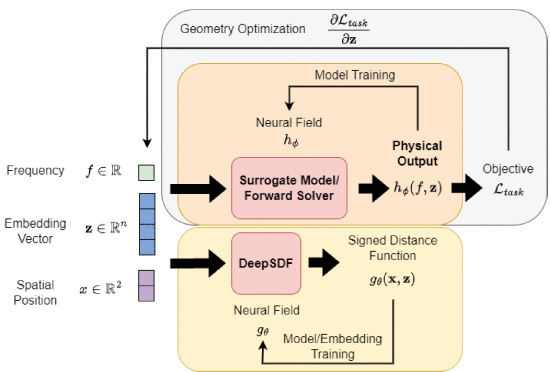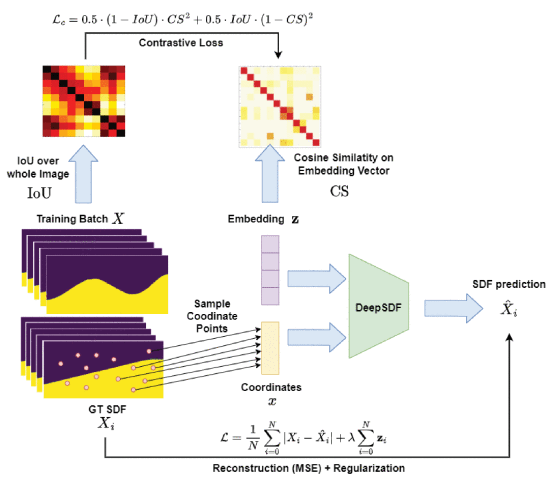
Parameter-free Neural Field-based Optimal Design of Nonuniform Transmission Lines
Publication Details
Journal/Conference: IEEE International Conference on Electronics, Circuits and Systems (ICECS) 2023
Authors: Philipp Gérard Trémuel, Robin Vetsch, Christoph Würsch, Klaus Frick, Efstratios Gavves
Parameter-free Neural Field-based Optimal Design of Nonuniform Transmission Lines
Paper Information
- DOI: 10.1109/ICECS58634.2023.10382765
- Conference: IEEE International Conference on Electronics, Circuits and Systems (ICECS) 2023
- Authors: Philipp Gérard Trémuel (UvA, ICE), Robin Vetsch (NTNU, ICE), Christoph Würsch (ICE), Klaus Frick, Efstratios Gavves (UvA)
- Affiliation: VIS Lab, University of Amsterdam
- Link: University of Amsterdam/VisLab, IEEEXplore
Abstract
This paper presents a novel method for resolution free, free-form shape optimization for nonuniform transmission lines using artificial neural networks. The research introduces an innovative approach that leverages machine learning techniques to optimize transmission line designs without being constrained by traditional parametric limitations.
 Figure 1 | Overview of the proposed method. The training consists of two steps. 1. Training the neural implicit representation of the geometries by learning an embedding representation of the SDF of the geometries using a neural field architecture. (bottom) 2. Training the neural field surrogate model for the physical output. Model input is an embedding vector and a frequency point. The outputs are the s-parameters for a specific frequency point. (top)
Figure 1 | Overview of the proposed method. The training consists of two steps. 1. Training the neural implicit representation of the geometries by learning an embedding representation of the SDF of the geometries using a neural field architecture. (bottom) 2. Training the neural field surrogate model for the physical output. Model input is an embedding vector and a frequency point. The outputs are the s-parameters for a specific frequency point. (top)
Key Methodology
The paper introduces a two-stage neural network approach:
1. Geometry Encoding
A low dimensional representation of the geometries by learning a neural field embedding with a contrastive loss function to group similar geometries. This creates an efficient way to represent complex transmission line shapes in a compressed format.
 Figure 2 | Proposed method for the contrastive learning of the geometrical encoding. For one training step, a batch of geometries is used and a similarity metric is calculated. This similarity metric is compared with the distance of the encoded embedding vectors z. This ensures that similar geometries are grouped in embedding space.
Figure 2 | Proposed method for the contrastive learning of the geometrical encoding. For one training step, a batch of geometries is used and a similarity metric is calculated. This similarity metric is compared with the distance of the encoded embedding vectors z. This ensures that similar geometries are grouped in embedding space.
2. Performance Prediction
A second neural network predicts the scattering parameters from the encoded geometry for a given frequency point, that are used to define the optimization objective in the frequency domain. This enables rapid evaluation of transmission line performance without expensive electromagnetic simulations.
Technical Advantages
Fully Differentiable Pipeline
The whole pipeline is fully-differentiable enabling the use of fast gradient based optimization methods. This characteristic allows for efficient optimization using modern machine learning optimization techniques.
Resolution Independence
The method is described as “resolution free,” meaning it can handle transmission line designs at various levels of geometric detail without being limited by mesh density or discretization constraints.
Results and Performance
The proposed model architecture shows promising results for the simple test case of optimizing a transmission line taper. The validation demonstrates the method’s effectiveness on fundamental transmission line optimization problems.
Key Benefits
The research highlights several advantages of their approach:
- Speed: The method is fast, stable and flexible to apply to different geometries with different constraints and requirements.
- Flexibility: Can be adapted to various transmission line geometries and optimization requirements
- Stability: Provides consistent optimization performance across different scenarios
Significance
This work represents a significant advancement in electromagnetic design optimization by:
- Eliminating the need for predefined geometric parameters
- Enabling free-form shape optimization of transmission lines
- Providing a fast alternative to traditional electromagnetic simulation-based optimization
- Demonstrating the potential of neural field approaches in RF/microwave engineering
Applications
The methodology has potential applications in:
- High-frequency circuit design
- Antenna feed networks
- Impedance matching networks
- Microwave component optimization
Future Implications
This parameter-free approach could revolutionize transmission line design by enabling engineers to explore more creative and optimal geometries without being constrained by traditional parametric design limitations. The neural field embedding technique could potentially be extended to other electromagnetic structures beyond transmission lines.